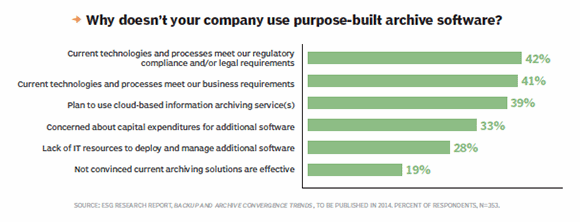We’re well past the notion that backup and archive aren’t the same thing, explains columnist Jason Buffington, but they may still leverage the same technologies.
We’re in what I believe is the third-wave of understanding the relationships between backups and archives. In a blog post I wrote last year, I suggested data protection as the appropriate umbrella term because it includes backup, snapshots, replication and archiving (among others). We know backup and archive aren’t the same thing, but we’ve looked at them from at least three different perspectives:
- Initially, backups and archives were treated as synonyms, with archive typically used to refer to older backups, often on tape, in contrast to recent backups on disk that are rapidly recoverable.
- Later, folks decided that backups (copies based on a point in time) and archives (copies based on an aspect of the data, its importance or applicability) were so different they required separate tools, separate storage systems and with separate strategies.
- Today, we’re seeing an authentic convergence of backup and archive. That’s not because people are confusing the two again, but because they’re seeing them as clearly complementary.
By storing data within an archive, one should expect to then store less data within a backup repository because the backup process will save what needs to be saved and skip the rest because it’s already stored in the archive. Today, not only are backup and archive planned as parts of a single data protection strategy, but increasingly both sets of data are stored within the same protection-storage container and even sometimes managed by one team. But can the archive and backup software be unified too?
In recent research on the convergence of backup and archive, Enterprise Strategy Group found that a staggering 83% of IT professionals use the archival features within their backup software as part of (or their only) archival solution. In fact, 35% used their backup software’s archive features as their only archive solution.
You might wonder why that’s happening. Certainly, there’s a wide range of extremely effective and feature-rich archival products, including those that are application-specific (e.g., for email) and industry-specific (e.g., medical imaging), as well as multipurpose archival solutions (such as Symantec’s Enterprise Vault or EMC’s SourceOne Archiving products). When we asked respondents in the research study, they said the archival features within their backup software were perceived as “good enough” to meet their organizations’ operational or regulatory needs. Other common reasons equated to “not enough (time/money).”

I don’t necessarily agree with the rationales of those who responded to the survey but, anecdotally, I can confirm the sentiment from other experiences. The good news is that storage pros seem to understand the real reasons for archiving, whereby one can store the right stuff (and only the right stuff) for longer periods of time, while reducing what’s held within the backup repository, as well as removing stagnant data from expensive production storage. The bad news is that great offerings that can drive those benefits are being usurped by backup products possibly because of “apathy” or “settling for good enough.” Either that or the archival features in some backup products have matured, becoming much more flexible and empowering, but are being mismarketed by vendors to the degree that vendors are only talking about the “backup” features of their products. What do you think?
[Originally posted on TechTarget as a recurring columnist]